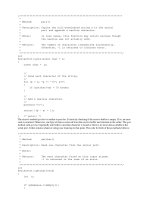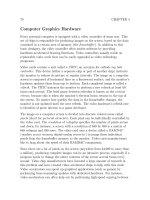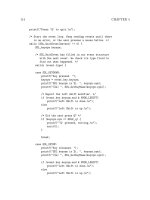Programming Linux Games phần 8 pps
Bạn đang xem bản rút gọn của tài liệu. Xem và tải ngay bản đầy đủ của tài liệu tại đây (208.9 KB, 37 trang )
290 CHAPTER 7
printf("Unable to accept: %s\n",
strerror(errno));
close(listener);
return 1;
}
/* We now have a live client. Print information
about it and then send something over the wire. */
inet_ntop(AF_INET, &sa.sin_addr, dotted_ip, 15);
printf("Received connection from %s.\n", dotted_ip);
/* Use popen to retrieve the output of the
uptime command. This is a bit of a hack, but
it’s portable and it works fairly well.
popen opens a pipe to a program (that is, it
executes the program and redirects its I/O
to a file handle). */
uptime = popen("/usr/bin/uptime", "r");
if (uptime == NULL) {
strcpy(sendbuf, "Unable to read system’s uptime.\n");
} else {
sendbuf[0] = ’\0’;
fgets(sendbuf, 1023, uptime);
pclose(uptime);
}
/* Figure out how much data we need to send. */
length = strlen(sendbuf);
sent = 0;
/* Repeatedly call write until the entire
buffer is sent. */
while (sent < length) {
int amt;
amt = write(client, sendbuf+sent, length-sent);
if (amt <= 0) {
/* Zero-byte writes are OK if they
are caused by signals (EINTR).
Otherwise they mean the socket
has been closed. */
NETWORKED GAMING WITH LINUX 291
if (errno == EINTR)
continue;
else {
printf("Send error: %s\n",
strerror(errno));
break;
}
}
/* Update our position by the number of
bytes that were sent. */
sent += amt;
}
close(client);
}
return 0;
}
Our server starts by creating a socket and binding it to a local port. It specifies
INADDR ANY for an address, since we don’t have any particular network interface
in mind. (You could use this to bind the socket to just one particular IP address
in a multihomed system, but games usually don’t need to worry about this.) It
then uses listen to set the socket up as a listener with a connection queue of
five clients.
Next comes the accept loop, in which the server actually receives and processes
incoming connections. It processes one client for each iteration of the loop. Each
client gets a copy of the output of the Linux uptime program. (Note the use of
popen to create this pipe.) The server uses a simple write loop to send this data
to the client.
If you feel adventurous, you might try modifying this program to deal with
multiline output (for instance, the output of the netstat program).
292 CHAPTER 7
Handling Multiple Clients
Linux is a multitasking operating system, and it’s easy to write
programs that handle more than one client at a time. There are several
ways to do this, but in my opinion the simplest is to create a separate
thread for each client. (See the pthread create manpage.) Be careful,
though—some sockets API functions are not thread-safe and shouldn’t
be called by more than one thread at a time.
If you’re interested in learning how to write solid UNIX-based network
servers, I suggest the book UNIX Network Programming [9]. It was of
great assistance as I wrote this chapter. Another useful reference is The
Pocket Guide to TCP/IP Sockets [3], a much smaller and more concise
treatment of the sockets API.
Working with UDP Sockets
UDP is a connectionless protocol. While TCP can be compared to a telephone
conversation, UDP is more like the postal service. It deals with individually
addressed packets of information that are not part of a larger stream. UDP is
great for blasting game updates across the network with reckless abandon. They
probably won’t all get there, but enough should arrive to keep the game running
smoothly.
As we did with TCP, we’ll demonstrate UDP with a sender and receiver. Here
goes:
Code Listing 7–3 (udpsender.c)
/* Simple UDP packet sender. */
#include <stdio.h>
#include <stdlib.h>
#include <errno.h>
#include <string.h>
#include <signal.h>
#include <unistd.h>
#include <netinet/in.h>
#include <netdb.h>
NETWORKED GAMING WITH LINUX 293
#include <arpa/inet.h>
#include <sys/socket.h>
struct hostent *hostlist; /* List of hosts returned
by gethostbyname. */
char dotted_ip[15]; /* Buffer for converting
the resolved address to
a readable format. */
int port; /* Port number. */
int sock; /* Our connection socket. */
struct sockaddr_in sa; /* Connection address. */
int packets_sent = 0;
/* This function gets called whenever the user presses Ctrl-C.
See the signal(2) manpage for more information. */
void signal_handler(int signum)
{
switch (signum) {
case SIGINT:
printf("\nReceived interrupt signal. Exiting.\n");
close(sock);
exit(0);
default:
printf("\nUnknown signal received. Ignoring.\n");
}
}
int main(int argc, char *argv[])
{
/* Make sure we received two arguments,
a hostname and a port number. */
if (argc < 3) {
printf("Simple UDP datagram sender.\n");
printf("Usage: %s <hostname or IP> <port>\n", argv[0]);
return 1;
}
/* Look up the hostname with DNS. gethostbyname
(at least most UNIX versions of it) properly
294 CHAPTER 7
handles dotted IP addresses as well as hostnames. */
printf("Looking up %s \n", argv[1]);
hostlist = gethostbyname(argv[1]);
if (hostlist == NULL) {
printf("Unable to resolve %s.\n", argv[1]);
return 1;
}
/* Good, we have an address. However, some sites
are moving over to IPv6 (the newer version of
IP), and we’re not ready for it (since it uses
a new address format). It’s a good idea to check
for this. */
if (hostlist->h_addrtype != AF_INET) {
printf("%s doesn’t seem to be an IPv4 address.\n",
argv[1]);
return 1;
}
/* inet_ntop converts a 32-bit IP address to
the dotted string notation (suitable for printing).
hostlist->h_addr_list is an array of possible addresses
(in case a name resolves to more than one IP). In most
cases we just want the first. */
inet_ntop(AF_INET, hostlist->h_addr_list[0], dotted_ip, 15);
printf("Resolved %s to %s.\n", argv[1], dotted_ip);
/* Create a SOCK_DGRAM socket. */
sock = socket(PF_INET, SOCK_DGRAM, IPPROTO_IP);
if (sock < 0) {
printf("Unable to create a socket: %s\n",
strerror(errno));
return 1;
}
/* Fill in the sockaddr_in structure. The address is already
in network byte order (from the gethostbyname call).
We need to convert the port number with the htons macro.
Before we do anything else, we’ll zero out the entire
structure. */
memset(&sa, 0, sizeof(struct sockaddr_in));
NETWORKED GAMING WITH LINUX 295
port = atoi(argv[2]);
sa.sin_port = htons(port);
/* The IP address was returned as a char * for various reasons.
Just memcpy it into the sockaddr_in structure. */
memcpy(&sa.sin_addr, hostlist->h_addr_list[0],
hostlist->h_length);
/* This is an Internet socket. */
sa.sin_family = AF_INET;
printf("Sending UDP packets. Press Ctrl-C to exit.\n");
/* Install a signal handler for Ctrl-C (SIGINT).
See the signal(2) manpage for more information. */
signal(SIGINT, signal_handler);
/* Send packets at 1s intervals until the user pressed Ctrl-C. */
for (;;) {
char message[255];
sprintf(message, "Greetings! This is packet %i.", packets_sent);
/* Send a packet containing the above string.
This could just as easily be binary data,
like a game update packet. */
if (sendto(sock, /* initialized UDP socket */
message, /* data to send */
strlen(message)+1, /* msg length + trailing NULL */
0, /* no special flags */
&sa, /* destination */
sizeof(struct sockaddr_in)) <= (int)strlen(message)) {
printf("Error sending packet: %s\n",
strerror(errno));
close(sock);
return 1;
}
printf("Sent packet.\n");
296 CHAPTER 7
/* To observe packet loss, remove the following
sleep call. Warning: this WILL flood the network. */
sleep(1);
packets_sent++;
}
/* This will never be reached. */
return 0;
}
This program starts out very much like the TCP client. It looks up the remote
system’s IP address with DNS, prepares an address structure, and creates a
socket. However, it never calls connect. The address structure is like an address
stamp that UDP slaps onto each outgoing packet. This example uses the sendto
function to send data over UDP. There are other ways to go about it, but
sendto is the most common. It takes an initialized UDP socket, a buffer of data,
and a valid address structure. sendto attempts to compose a UDP packet and
send it on its way across the network. Since this is UDP, there is no guarantee as
to whether or not this packet will actually be sent.
Function sendto(sock, buf, length, flags, addr,
addr len)
Synopsis Sends a UDP datagram to the specified address.
Returns Number of bytes sent, or −1 on error. There is no
guarantee that the message will actually be sent
(though it’s likely).
Parameters sock—Initialized SOCK DGRAM socket.
buf—Buffer of data to send.
length—Size of the buffer. This is subject to
system-dependent size limits.
flags—Message flags. Unless you have a specific
reason to use a flag, this should be zero.
addr—sockaddr in address structure that specifies
the message’s destination.
NETWORKED GAMING WITH LINUX 297
addr len—Size of the address structure. sizeof
(addr) should work.
If you want to test out your network’s capacity (or just irritate the sysadmin),
take the sleep call out of the sender program. This will make the program fire
off packets as quickly as possible. It’s not a good idea to do this in a game—it
would be wise to limit the transmission speed so that other applications can
coexist with your game on the network. (I tried this, and my network hub lit up
like a Christmas tree.)
And now the receiver:
Code Listing 7–4 (udpreceiver.c)
/* Simple UDP packet receiver. */
#include <stdio.h>
#include <stdlib.h>
#include <errno.h>
#include <string.h>
#include <signal.h>
#include <unistd.h>
#include <netinet/in.h>
#include <netdb.h>
#include <arpa/inet.h>
#include <sys/socket.h>
int port; /* Port number. */
int sock; /* Our connection socket. */
struct sockaddr_in sa; /* Connection address. */
socklen_t sa_len; /* Size of sa. */
/* This function gets called whenever the user presses Ctrl-C.
See the signal(2) manpage for more information. */
void signal_handler(int signum)
{
switch (signum) {
case SIGINT:
printf("\nReceived interrupt signal. Exiting.\n");
close(sock);
298 CHAPTER 7
exit(0);
default:
printf("\nUnknown signal received. Ignoring.\n");
}
}
int main(int argc, char *argv[])
{
/* Make sure we received one argument,
the port number to listen on. */
if (argc < 2) {
printf("Simple UDP datagram receiver.\n");
printf("Usage: %s <port>\n", argv[0]);
return 1;
}
/* Create a SOCK_DGRAM socket. */
sock = socket(PF_INET, SOCK_DGRAM, IPPROTO_IP);
if (sock < 0) {
printf("Unable to create a socket: %s\n",
strerror(errno));
return 1;
}
/* Fill in the sockaddr_in structure. The address is already
in network byte order (from the gethostbyname call).
We need to convert the port number with the htons macro.
Before we do anything else, we’ll zero out the entire
structure. */
memset(&sa, 0, sizeof(struct sockaddr_in));
port = atoi(argv[1]);
sa.sin_port = htons(port);
sa.sin_addr.s_addr = htonl(INADDR_ANY); /* listen on
all interfaces */
/* This is an Internet socket. */
sa.sin_family = AF_INET;
/* Bind to a port so the networking software will know
NETWORKED GAMING WITH LINUX 299
which port we’re interested in receiving packets from. */
if (bind(sock, (struct sockaddr *)&sa, sizeof(sa)) < 0) {
printf("Error binding to port %i: %s\n",
port,
strerror(errno));
return 1;
}
printf("Listening for UDP packets. Press Ctrl-C to exit.\n");
/* Install a signal handler for Ctrl-C (SIGINT).
See the signal(2) manpage for more information. */
signal(SIGINT, signal_handler);
/* Collect packets until the user pressed Ctrl-C. */
for (;;) {
char buf[255];
/* Receive the next datagram. */
if (recvfrom(sock, /* UDP socket */
buf, /* receive buffer */
255, /* max bytes to receive */
0, /* no special flags */
&sa, /* sender’s address */
&sa_len) < 0) {
printf("Error receiving packet: %s\n",
strerror(errno));
return 1;
}
/* Announce that we’ve received something. */
printf("Got message: ’%s’\n", buf);
}
/* This will never be reached. */
return 0;
}
The UDP receiver program starts up much like our TCP server, except that it
doesn’t call listen or accept (since UDP is, of course, connectionless). After
300 CHAPTER 7
binding to a local port, the program calls recvfrom to retrieve datagrams.
Datagrams are individual packages; you have to receive them either all at once
or not at all (unlike TCP, which provides a stream of bytes that you can pick off
one at a time). recvfrom is a blocking call; it will wait until a datagram arrives
before it returns.
Function recvfrom(sock, buf, length, flags, addr,
addr len)
Synopsis Receives a UDP datagram from a local port.
Returns Number of bytes received, or −1 on error.
Parameters sock—Initialized SOCK DGRAM socket that has been
associated with a local port with bind.
buf—Buffer to receive incoming data.
length—Maximum number of bytes to receive.
flags—Message flags. Unless you have a specific
reason to use a flag, this should be zero.
addr—sockaddr in address structure to receive
information about the sender of the message.
addr len—Size of the address structure. sizeof
(addr) should work.
That’s it for UDP! Now it’s time to apply this stuff (TCP at least) to Penguin
Warrior.
Multiplayer Penguin Warrior
So far, Penguin Warrior has supported only a computer-controlled opponent,
and a fairly unintelligent one at that. However, it’s a lot more fun to play
against humans than against Tcl scripts.
This will be a simple networking system, as games go. It will use a simple TCP
scheme to keep the game in sync, and it will not make use of UDP. (That would
be overkill for a game like Penguin Warrior.) It will trust that the clients are
secure (that is, that they have not been hacked for the purpose of cheating).
Nonetheless, it should give you an idea of what goes into a network-ready game.
NETWORKED GAMING WITH LINUX 301
Network Gaming Models
The ultimate goal of a networked game is to allow two or more players to
participate in a single game universe at the same time. Whether they are
competing against each other or cooperating in a battle against other opponents
is of little consequence. All networkable games need to solve the same basic
problem of keeping the players informed about the state of the running game.
Here are some of the more common approaches to this problem:
Client/server
Each player uses a local copy of the game (a client) to connect to
a single central machine (the game server or dedicated server)
that knows the game’s rules and serves as a master authority on
the game’s state. Clients send updates to the server, and the
server sends authoritative updates back to each client. In this
model, the server is always right. It is very difficult to cheat in a
client/server gaming situation, because every client talks to the
same server, and the server applies the same rules to everyone.
This is the most common setup for major online games.
Peer-to-peer
This approach is good for small games like Penguin Warrior. Each
player’s computer maintains a local copy of the game’s state and
informs all of the other computers whenever anything changes.
The main problem with this system is that it is very easy for
players to cheat by modifying their local copies of the game. There
is no centralized “referee” in peer-to-peer multiplayer games.
Client is a server
In some cases it is convenient to build the game server code into
the game itself, so that any player with a fast computer and a
reasonably fast network connection can “host” a multiplayer game
for friends. This method is a little less prone to cheating than the
peer-to-peer model, but an untrustworthy player could covertly
modify the server to gain an advantage.
It is fallacious to think that closed source binary games are immune to cheaters;
Ultima Online and Diablo are evidence to the contrary. Any sufficiently idle
302 CHAPTER 7
Player Player
Player
Player
Player
Game server
(game universe)
Player Player
Player Player
Player and
game server
(same computer)
Peer-to-peer model
Client-server model
Client doubling as server
Figure 7–1: Three ways to set up a network game
3r33t h@x0ring d00d with a hex editor can have a field day with these games. If
you are concerned about possible cheating, the only real solution is to use a
design that enforces equality between the players. (Penguin Warrior does not use
such a design; it would be trivial to cheat in a multiplayer game.)
Penguin Warrior’s Networking System
In the interest of simplicity, Penguin Warrior will use the peer-to-peer model.
One copy of the game will act as a TCP server, and the other will connect as a
TCP client. It does not matter which role goes to which player; the players are
completely equal after the link is established. Once the two players are linked,
they will begin to exchange update packets with one another. Each update
packet will contain the world coordinates of the player that sent it (in other
words, it says, “I’m at this position; now reply with your position”). The players
will send these packets back and forth as quickly as possible (with a small speed
brake to keep from flooding the network). The game will end when the
connection is broken (that is, when one of the players exits the game). It’s
NETWORKED GAMING WITH LINUX 303
simple, but it should work well given a reasonably fast network (not a modem
connection).
Source Files
The Penguin Warrior networking system consists of network.c,
network.h, and some heavy modifications to main.c. You can find
this chapter’s code in the pw-ch7/ directory of the book’s source
archive. No additional libraries are needed for networking support;
that’s built into the operating system.
What happens when a player fires or gets hit by a shot? Update packets also
contain fields for this information. Whenever a player fires, the networking
system sends a packet with the “fire” flag set. The other player should then
display an appropriate moving projectile. Players keep track of their own
projectiles; if you press the fire button and launch a volley at your opponent,
your copy of Penguin Warrior is responsible for tracking the projectiles to their
respective destinations.
4
If your copy of the game decides that the other player
has been hit, it sends this information in the next outgoing network packet.
For reference, here’s the Penguin Warrior update packet structure:
typedef struct net_pkt_s {
Sint32 my_x, my_y;
Sint32 my_angle;
Sint32 my_velocity;
Uint8 fire;
Uint8 hit;
} net_pkt_t, *net_pkt_p;
There’s not much to it (which is good, since this structure is sent over the wire
many times each second). Note that the values are sent as Sint32 (the SDL
signed 32-bit integer type) instead of double (which the game uses internally).
4
Weapons are not actually present in this version of the game. We’ll add them in Chapter 9.
Our protocol for handling weapons is in place, though.
304 CHAPTER 7
The exact meaning and encoding of double can vary between platforms. It
probably won’t (it’s a standard IEEE double-precision floating-point number on
most platforms), but Murphy’s Law indicates that we shouldn’t take anything
for granted. By applying a simple network encoding formula (given by macros in
network.h), we ensure that our coordinates will always reach the other end
intact, regardless of the CPU types involved.
Warning
You can often ignore endianness issues when you’re writing a
single-player game or coding for a particular type of machine, but unlike
Microsoft’s flagship products, Linux is not limited to the arcane x86
CPU architecture. If there’s any possibility at all that your networked
game or application will need to exchange data with another type of
system (for instance, a multiplayer game between a PC and an
UltraSPARC), it’s important to watch out for endianness and other
encoding issues. Never assume that basic datatypes will be exactly the
same on any two platforms. The sockets API can help with its network
byte order macros, and SDL provides similar macros for ensuring a
particular endianness.
Coding time! Here’s network.c, which implements the basic two-player protocol
over TCP.
Code Listing 7–5 (network.c)
#include <stdio.h>
#include <stdlib.h>
#include <unistd.h>
#include <sys/socket.h>
#include <arpa/inet.h>
#include <string.h>
#include <errno.h>
#include <netdb.h>
#include "network.h"
void CreateNetPacket(net_pkt_p pkt, player_p player,
int firing, int hit)
{
NETWORKED GAMING WITH LINUX 305
/* Fill in all of the relevant values, calling
our conversion macro to preclude endianness
problems. */
pkt->my_x = DOUBLE_TO_NET(player->world_x);
pkt->my_y = DOUBLE_TO_NET(player->world_y);
pkt->my_angle = DOUBLE_TO_NET(player->angle);
pkt->my_velocity = DOUBLE_TO_NET(player->velocity);
pkt->fire = (Uint8)firing;
pkt->hit = (Uint8)hit;
}
void InterpretNetPacket(net_pkt_p pkt,
double *remote_x, double *remote_y,
double *remote_angle,
double *remote_velocity,
int *firing, int *hit)
{
/* Decode the values in the packet and store
them in the appropriate places. */
*remote_x = NET_TO_DOUBLE(pkt->my_x);
*remote_y = NET_TO_DOUBLE(pkt->my_y);
*remote_angle = NET_TO_DOUBLE(pkt->my_angle);
*remote_velocity = NET_TO_DOUBLE(pkt->my_velocity);
*firing = (int)pkt->fire;
*hit = (int)pkt->hit;
}
int ConnectToNetgame(char *hostname, int port, net_link_p link)
{
int sock;
struct sockaddr_in addr;
struct hostent *hostlist;
/* Resolve the host’s address with DNS. */
hostlist = gethostbyname(hostname);
if (hostlist == NULL || hostlist->h_addrtype != AF_INET) {
fprintf(stderr, "Unable to resolve %s: %s\n",
hostname,
strerror(errno));
return -1;
306 CHAPTER 7
}
/* Save the dotted IP address in the link structure. */
inet_ntop(AF_INET, hostlist->h_addr_list[0],
link->dotted_ip, 15);
/* Load the address structure with the server’s info. */
memset(&addr, 0, sizeof (struct sockaddr_in));
addr.sin_family = AF_INET;
memcpy(&addr.sin_addr, hostlist->h_addr_list[0],
hostlist->h_length);
addr.sin_port = htons(port);
/* Create a TCP stream socket. */
sock = socket(PF_INET, SOCK_STREAM, IPPROTO_TCP);
if (sock < 0) {
fprintf(stderr, "Unable to create socket: %s\n",
strerror(errno));
return -1;
}
printf("Attempting to connect to %s:%i \n",
link->dotted_ip, port);
/* Ready to go! Connect to the remote machine. */
if (connect(sock, (struct sockaddr *)&addr,
sizeof (addr)) < 0) {
fprintf(stderr, "Unable to connect: %s\n",
strerror(errno));
close(sock);
return -1;
}
/* Copy the socket and the address into the link structure. */
link->sock = sock;
link->addr = addr;
printf("Connected!\n");
return 0;
}
NETWORKED GAMING WITH LINUX 307
int WaitNetgameConnection(int port, net_link_p link)
{
int listener, sock;
struct sockaddr_in addr;
socklen_t addr_len;
/* Create a listening socket. */
listener = socket(PF_INET, SOCK_STREAM, IPPROTO_IP);
if (listener < 0) {
fprintf(stderr, "Unable to create socket: %s\n",
strerror(errno));
return -1;
}
/* Set up the address structure for the listener. */
addr_len = sizeof (addr);
memset(&addr, 0, addr_len);
addr.sin_family = AF_INET;
addr.sin_port = htons(port);
addr.sin_addr.s_addr = htonl(INADDR_ANY);
/* Bind the listener to a local port. */
if (bind(listener, &addr, addr_len) < 0) {
fprintf(stderr, "Unable to bind to port %i: %s\n",
port, strerror(errno));
close(listener);
return -1;
}
/* Make this a listening socket. */
if (listen(listener, 1) < 0) {
fprintf(stderr, "Unable to listen: %s\n",
strerror(errno));
close(listener);
return -1;
}
printf("Waiting for connection on port %i.\n", port);
/* Accept a connection. */
if ((sock = accept(listener, (struct sockaddr *)&addr,
&addr_len)) < 0) {
308 CHAPTER 7
fprintf(stderr, "Unable to accept connection: %s\n",
strerror(errno));
close(listener);
return -1;
}
/* Ready to go! Save this info in the link structure. */
link->sock = sock;
link->addr = addr;
inet_ntop(AF_INET, &addr.sin_addr, link->dotted_ip, 15);
printf("Connected!\n");
return 0;
}
int ReadNetgamePacket(net_link_p link, net_pkt_p pkt)
{
int remaining, count;
remaining = sizeof (struct net_pkt_s);
count = 0;
/* Loop until a complete packet arrives.
This could block indefinitely, but it
typically won’t, and it’s of less importance
since the networking code runs in a separate
thread. */
while (remaining > 0) {
int amt;
/* Read as much as possible. */
amt = read(link->sock, ((char *)pkt)+count, remaining);
/* If read returns a positive value, or zero
with errno == EINTR, there is no error. */
if (amt <= 0 && errno != EINTR) {
fprintf(stderr, "ReadNetgamePacket: read failed: %s\n",
strerror(errno));
return -1;
}
NETWORKED GAMING WITH LINUX 309
/* Increment the counters by the amount read. */
remaining -= amt;
count += amt;
}
return 0;
}
int WriteNetgamePacket(net_link_p link, net_pkt_p pkt)
{
int remaining, count;
remaining = sizeof (struct net_pkt_s);
count = 0;
/* Loop until we’ve written the entire packet. */
while (remaining > 0) {
int amt;
/* Try to write the rest of the packet.
Note the amount that was actually written. */
amt = write(link->sock, ((char *)pkt)+count, remaining);
/* Same error semantics as ReadNetgamePacket. */
if (amt <= 0 && errno != EINTR) {
fprintf(stderr, "WriteNetgamePacket: read failed: %s\n",
strerror(errno));
return -1;
}
/* Increments the counters by the number of
bytes written. */
remaining -= amt;
count += amt;
}
return 0;
}
void CloseNetgameLink(net_link_p link)
{
310 CHAPTER 7
/* Close the socket connection. */
close(link->sock);
link->sock = -1;
}
The first two functions, CreateNetPacket and InterpretNetPacket, help us
deal with network packets. We can pretty much be as sloppy as we want about
our internal game state variables, but organization is very important when we’re
communicating with another program at a high speed over network. These
functions convert between a game’s state and network packet structures so that
our main code doesn’t need to worry about the “wire format” of the data.
ConnectToNetgame tries to connect to another copy of Penguin Warrior over the
network. After resolving the remote system’s IP address with DNS, it attempts
a normal TCP socket connection and stores the connected socket in the provided
net link t structure. Penguin Warrior performs no synchronization or
negotiation; it assumes that whatever answers the connection request is a copy of
Penguin Warrior that speaks the same protocol. It would be a simple matter to
exchange some small piece of data over the link to make sure of this before
starting the game.
The next function, WaitNetgameConnection, waits for a copy of Penguin
Warrior to connect on a given port number. This is the counterpart of
ConnectToNetgame. It consists of simple TCP server code that we’ve already
discussed. It is important to realize that this is not a client/server game; the
“server” is called that only because it waits for another player, the “client,” to
connect. After the connection, there is no difference between the two sides of the
connection.
ReadNetgamePacket and WriteNetgamePacket send and receive complete game
update packets over the network. We could probably get away with using simple
read or write calls, but there’s no guarantee that either of these calls will
process the full amount of data requested. To handle this, ReadNetgamePacket
and WriteNetgamePacket keep track of the amount of data transferred and loop
until a complete packet has been processed. It would be simple to adapt these
routines into general-purpose socket reading and writing utilities.
Finally, CloseNetgameLink closes a multiplayer game link. It uses the normal
close function to shut down the socket. The TCP/IP protocol handles this
without further interaction.
NETWORKED GAMING WITH LINUX 311
That’s it for the networking code. Everything else is in main.c. We won’t
reprint it here, since it would be largely redundant, but it’s worth taking a look
at to see the changes. We’ve added UpdateNetworkPlayer to send and receive
update packets and a new thread (launched with NetworkThread) to run the
networking in the background (so that the speed of our main loop isn’t limited
by the latency of the network). Note also that the player data structures are now
protected by a mutex so that the network thread and the main loop can safely
access them without bumping into each other.
Network Game Performance
Anyone who’s ever played a multiplayer action game has probably felt the
frustration of lining up for a kill and having the game suddenly slow to an
unplayable crawl. The Internet is enormous, and its performance range is
anywhere from solid to flaky. Multiplayer games unfortunately require a very
high level of sustained performance, and it’s left to the game developer to make
ends meet in this turbulent medium. In this section we’ll make some
observations about network performance and suggest ways to squeeze acceptable
performance out of the Internet.
Gamers often grumble about slow network performance. Two primary factors
play into this problem. Packet loss is the tendency of overloaded or unreliable
networks to lose information at random. We’ve already mentioned this with
respect to UDP—if you send a UDP packet across the network, it might get
there, and it might not. TCP detects and corrects missing packets, but they
throw a monkey wrench into the communication process and kill performance.
There’s not a lot you can do to prevent packet loss, unless you intend to install
your own high-speed communication lines; you can only minimize its effects on
your games. The most common way of dealing with packet loss is simply to
ignore it. TCP holds up the transmission pipeline until packets arrive at the
other end intact, at which point it’s probably past time to send the next update
anyway. (In this case, error correction actually hurts game performance.) UDP
does not have this problem.
Another culprit of lousy network performance is latency, the time it takes a
given piece of information to travel across the network. Latency depends both on
the speed of the underlying network and on its current traffic load. Unless your
312 CHAPTER 7
game uses prediction or another clever strategy, players will always be out of
sync by the amount of time it takes them to exchange network packets. A
reasonable average latency for Internet games on fast connections is 100
milliseconds (ms), and any game should be able to handle this amount. However,
the average latency can easily rise to the vicinity of 500 to 1000 ms if slow
network devices (modems) are involved, and at this level it can become quite
distracting. (For instance, a player might fire a weapon and see the effects a full
second later.) Some games use statistics to guess what the other players will do
during the next update interval, which can make a multiplayer game much
smoother. Prediction would be overkill for something like Penguin Warrior, but
Quake and Half-Life make heavy use of this technique.
Security Issues
For some reason, many players get a thrill out of disrupting the normal course of
a game for others. Players of Diablo and Ultima Online have access to any
number of programs that mess with the underlying game code to give them an
unfair advantage. Fans of the Half-Life multiplayer modification Counter-Strike
constantly run into “skin cheaters” who modify their player models to make
themselves invisible or make their enemies easier to spot. Cheating is an
unfortunate part of online gaming. There are a lot of smart people out there
who get a kick out of gaining an unfair advantage in the games they play. As if
this weren’t bad enough, these people often make their cheats available to their
friends, and the problem grows exponentially. Although no game is perfectly
secure against the determined cheater, good design can make cheating very
difficult.
The problem is pretty simple, actually. Most major online games use a
client/server model (see page 301). Client/server games should theoretically do
all of the game world’s processing and error checking on the server side, leaving
nothing important to the clients. If this were always the case, hacked clients
would be of no consequence, and games like Half-Life would be free of cheaters.
For basic performance reasons, however, very few games actually work this way.
If a client had to run everything through the server, performance would be
abysmal. Most games at least let the client do a bit of preloading, prediction, or
collision detection. This work stays hidden from the player, unless someone
NETWORKED GAMING WITH LINUX 313
hacks the program to make unfair use of this information. This is exactly what
happened to Quake when id Software released its source code. Quake placed a
bit too much trust in the game client, and unscrupulous gamers were quick to
take advantage of this.
The only way to get around this problem is to make sure that any
responsibilities assigned to a client can be verified by the server and to limit the
amount of information the client gets about the state of the game. Players can
and will figure out how to modify a game to report false update information or
to misuse the information it receives. In a world of hex editors, protocol sniffers,
and bored college students like myself, no game is safe from modification. Plan
on it, and make sure it can’t hurt anything.
We’ll now put Penguin Warrior on hold for a little while so we can hack some
framebuffer console code. We’ll pick the game back up in Chapter 9 and add all
of the goodies it’s missing, including weapons, player-to-player chat, and score
counters. We’ll also combine the code from chapters 5, 6, and this chapter into a
final version with all of the subsystems present. By the end of Chapter 9,
Penguin Warrior will be a fully operational Linux game.









